Best viewed on desktop computer
Four panels in the Foyer of Mary Immaculate Center, Northampton, Pennsylvania.
Reproduced from Color Proofs of the Cooke Publishing Company appearing in MARY IMMACULATE SEMINARY: a Memory Book 1939-1997. Text courtesy of Vincentian Archives, Philadelphia, Father John Carven, CM, Archivist.
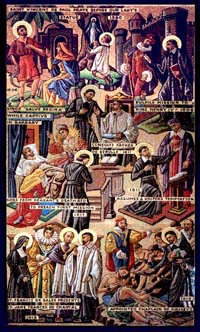
|
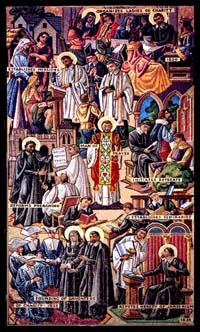
|
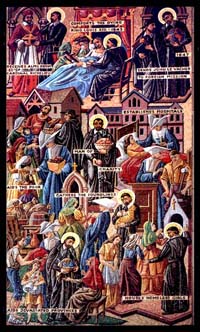
|
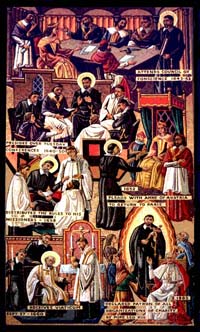
|
For closeup views of the panels, click on each title below:
Panel 1
Devotion to Mary
1590–Child Vincent prays to Mary.
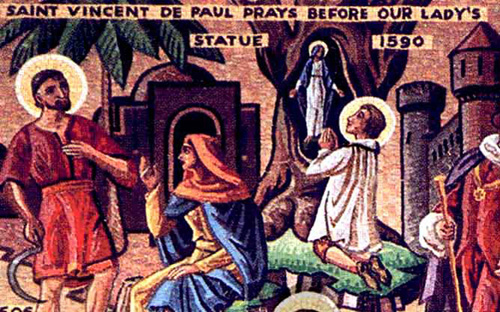
In Vincent de Paul's youth there was no known shrine to our Blessed Mother in the region of Puy, neither at Buglose nor in a tree as pictured here. Nevertheless, he had for Mary a tender, filial devotion and wished that this devotion be one of the most sacred traditions of his sons and daughters.
Vincent wrote to his sons in 1656: "The practice of wearing the rosary on one's belt is always observed in this house. I think it will be well for you to maintain in your house the custom of wearing a rosary on the belt or to introduce it if it does not already exist." In another place he declared, "It is a holy and edifying custom." He told the Daughters of Charity: "The rosary is a most efficacious prayer when it is said well. . . . It is your breviary."
Enslaved in Barbary
1606-In Barbary.
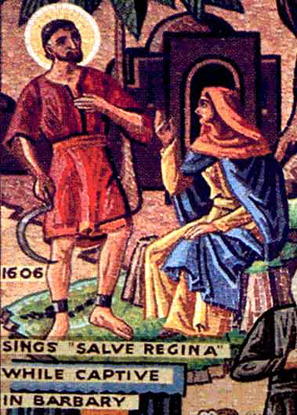
Vincent's devotion to Mary was also evident when he sang the SALVE REGINA to the Greek Orthodox wife of one of his masters in Tunis. "God always kept alive in me that I would be freed because of my unceasing prayers to Him and to the Blessed Virgin Mary, through whose sole intercession I firmly believe I was delivered."
Was Saint Vincent de Paul really a captive in Tunis (1605-1607) or was it a canard he foisted on M. Comet in 1607? Although this episode in his life has been much debated, notice the Saint's signature, below, from the letter reporting his captivity. Notice the PARAPH appended to his signature, the stylized flourish after his name. Saint Vincent appended the paraph which he developed for himself to letters or documents of a legal nature, not to ordinary correspondence. It acted as his identification sign and engendered legal consequences if what he wrote was not true. Thus, more credence should be given to the authenticity of the captivity letters because of this legal procedure and to the veracity of the Saint since by the paraph he would have opened himself to a charge of perjury.
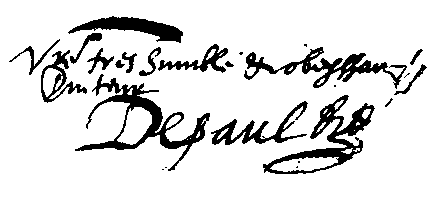
Mission to Henry IV
1608–King Henry IV.
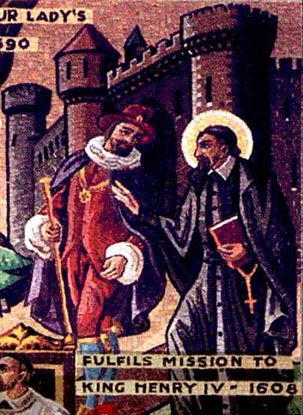
Another mystery in the early life of Monsieur Vincent involves the secret mission of the Saint to King Henry IV, secret because Louis Abelly, who recounts it, left no documentation substantiating his narration; and deficiencies in his story cannot be closed. According to him, Vincent met in Rome Cardinal Arnauld d'Ossat, French Ambassador to the Holy See, who was negotiating the reconciliation of Henry IV with the Holy See. The Cardinal entrusted to Vincent a diplomatic mission to be carried out on his return to Paris in 1608, to deal with a secret affair which would have been rash to commit to writing. Subsequent to this mission, and whether connected with it or not, Saint Vincent eventually became Chaplain to Marguerite of Valois, the repudiated wife of Henry IV.
Spiritually guided by Fr. de Berulle
1611–De Bérulle.
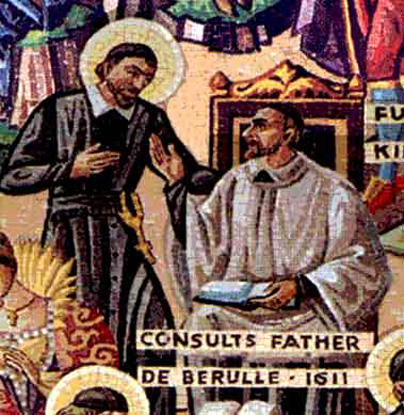
For many years Vincent de Paul was the docile instrument in the hands of Father Pierre de Bérulle and Father Andre Duval.
After his arrival in Paris, M. Vincent, in need of a wise adviser, made the acquaintance of Bérulle, who had gathered around himself the most virtuous and eminent priests of Paris. Guided at this stage in his life by the future Cardinal de Berulle, the Saint reached for a higher level of virtue and the ascent was to be a continuous journey of a soul aided by this wise councillor. Of equal stature was Andre Duval, a Doctor of the Sorbonne, Vincent's most trusted advisor, a man whom the Saint regarded as inspired by Heaven. He believed that the Will of God had been made known to himself by the voice of Andre Duval. Vincent never made an important decision without having recourse to Duval's wisdom and counsel.
Tempted against his Faith
1611–Temptation.
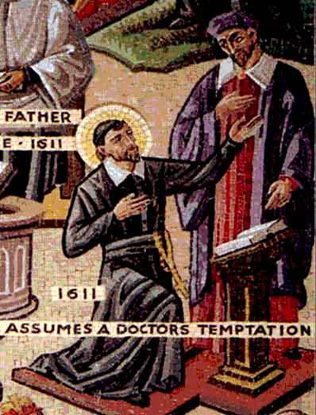
God permitted Saint Vincent, early in his life, to be tried with temptations and trials to trust and faith.
A judge, with whom Vincent shared an apartment, accused him of stealing his valuables. Although innocent, the Saint lived under a cloud for six years until the real thief confessed.
Another colleague, a Doctor of Theology and a Canon Theologian, who had entered the retinue of Queen Marguerite of Valois, was assailed by a strong temptation against his faith-had horrible, blasphemous thoughts against Jesus Christ, temptations to despair, agitation about throwing himself out a window. Monsieur Vincent forbade him to say any prayers, not even the Divine Office, or to celebrate Mass. Besides praying for the priest, Vincent offered himself in place of the theologian. The Saint, in effect, submitted himself to a severe assault against his faith. To combat the temptations he placed a copy of the Creed next to his heart. When assailed, he placed his hand there as a sign that he rejected temptation. From this interior struggle, which lasted three or four years, he emerged greatly strengthened in faith-also more enlightened, committed to serving God in the person of His abandoned people.
Start of the Mission
1617–First Mission.
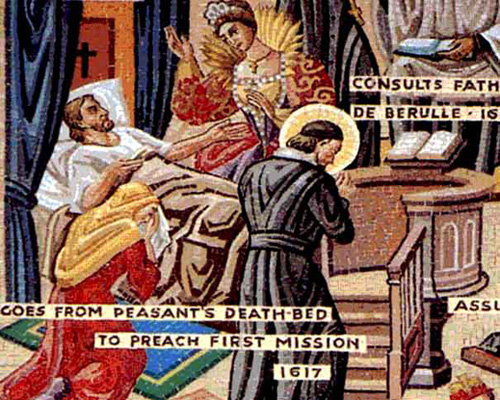
"Madame, were it not for this general confession I would have been damned." A dying peasant had wanted to see M. Vincent, who suggested to him a general confession. Later, in the presence of Madame de Gondi, on whose estates he lived, the peasant admitted publically his many sacrilegious confessions and the great sins of his past life. The Lady thereupon resolved to establish the preaching of missions on her estates. On January 15, 1617, at her urging, her chaplain preached in the church of Folleville to persuade the local people to make a general confession. Subsequently, Madame de Gondi established a fund of 6,000 livres to entice a community to preach missions on all her estates every five years. Thus began the apostolate of preaching missions to whose value M. Vincent was most committed.
Guided Visitation Sisters
1619–Visitation Nuns.
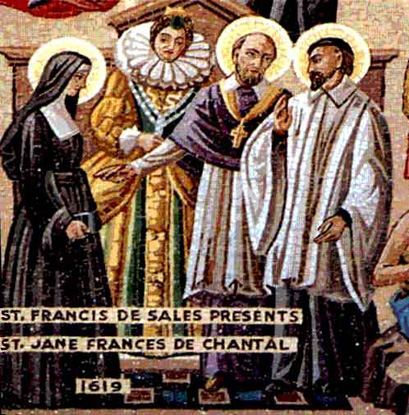
The widow Jane Frances Frémiot de Chantal and the saintly Bishop of Geneva, Francis de Sales, came to Paris in order to establish there a monastery of the Visitation Order they had founded. While in Paris (1619-1622) they became acquainted with Vincent de Paul, whom she and Francis de Sales judged to be the best qualified and most capable person to assume charge of the Visitation in Paris. Reluctant though Vincent was, the Archbishop Jean-François de Gondi, urged by Saint Jane Frances, commanded him to assume the office of Superior and Spiritual Father of the Visitation in the city of Paris (1622). Throughout her life (d. 1641) Saint Jane Frances kept in close contact with Monsieur Vincent, whom she consulted for her spiritual direction and with regard to the business affairs of her Order. Except for the eighteen months (1646-1647) when he balked at this responsibility, Saint Vincent remained Superior and Spiritual Father for the Visitation in Paris. Under his spiritual guidance the nuns lived in great simplicity and a sovereign contempt of the world, without artifice or guile, obedient both in heart and mind, and perfectly united.
Ministered to Galleys
1619–Galley Slaves.
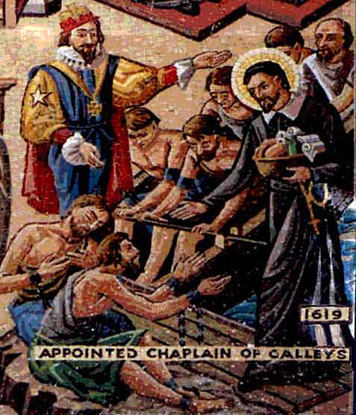
Philippe-Emmanuel de Gondi, General of the Galleys of France, urged Louis XIII to appoint Vincent de Paul Chaplain General of the Galleys, with all the rights and honors of an officer of the line. Appointed February 8, 1619, Vincent had full authority to visit the galleys, to establish that all on board were carrying out their duties: convicts, chaplains, jailers, and even physicians.
He supervised the bodily and spiritual needs of the convicts. He visited in Paris those awaiting transport to the galleys; had hospitals built in Paris and Marseilles for them-the contract of April 17, 1625, which gave birth to the Congregation of the Mission, mandated that spiritual assistance to the galley slaves was one of the duties of the new Community. Legend has it-based on vague and fragile proof, hearsay information-that in Marseilles the Saint, moved by the plight of a convict forced to abandon wife and children to a life of abject poverty, convinced the authorities to allow the Chaplain General to replace the convict. When later questioned, M. Vincent merely smile–shrugged his shoulders we might say.
Panel 2
Man of Prayer
Man of Prayer.
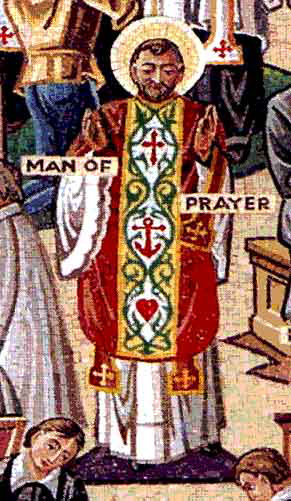
"What the sword is to the soldier, mental prayer is to the one dedicated to the service of the altar." What Saint Vincent expressed in his letters he put into action. He never failed to devote an hour each morning to his mental prayer. Despite all his duties and the unusual interruptions to his routine, he regularly rose at four A.M., went to church for mental prayer, offered Mass, and recited the Divine Office.
Prayer is to be the beginning and preparation for the day he told his sons and daughters. "It is not enough for us to celebrate Mass; we should also offer this sacrifice with the greatest possible devotion. Let us strive to offer our Masses to God in the same spirit as Jesus Christ offered Himself, and as perfectly as our poor and miserable nature permits." To the Daughters of Charity he said: "It is not only the priest who offers up the Holy Sacrifice but also those who are present, and I feel quite sure that when your have been well-instructed, you will have great devotion to the Mass, for it is the center of devotion."
Established Missions
Established Missions.
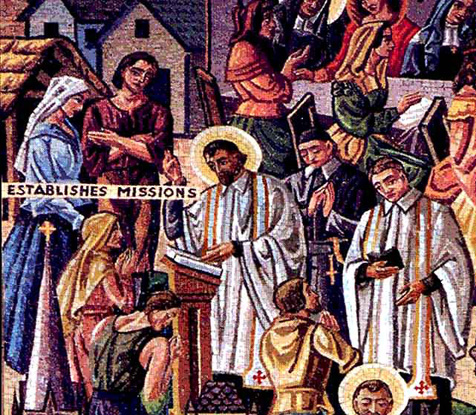
From 1617 to 1625 M. Vincent was among those who evangelized the towns, villages, and hamlets scattered throughout the de Gondi estates. So strong did his faith in missions develop that he avowed: "It would need an angel from Heaven to persuade us that it is God's Will that we should abandon the work of the missions." Madame de Gondi also espoused that thought. On April 17, 1625, she contracted w!th M. Vincent to establish a Community which would made missions its life's work—The Congregation of the Mission for which she endowed a fund for its permanent support.
Vincent formed an association with three other priests on September 4, 1617, pledging 1) to strive for one's own perfection by exerting every effort to practice the virtues which the sovereign Master has been pleased to teach us by word and example; 2) to preach the gospel to the poor, especially the country people; 3) to help ecclesiastics in acquiring the knowledge and virtues necessary for their state. Today, others who have joined them agree to: 1) make every effort to put on the spirit of Christ Himself in order to acquire holiness appropriate to their vocation; 2) work at evangelizing the poor, especially the more abandoned; 3) help the clergy and laity in their formation and lead them to a fuller participation in the evangelizing of the poor. On March 1, 1624 Saint Vincent had accepted as a gift from the Archbishop of Paris the College des Bons-Enfants. This became the base for this new association. The Missionaries brought to this work what Saint Vincent called the core virtues of a Vincentian: simplicity, humility, meekness, mortification and zeal for souls.
Established Seminaries
Established Seminaries.
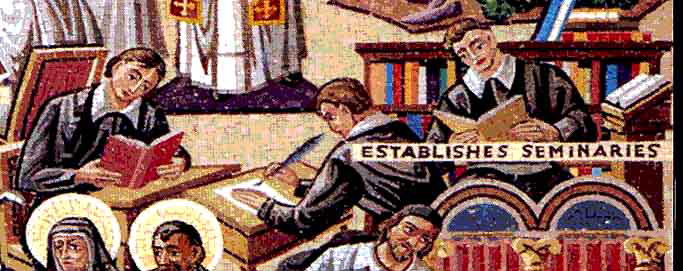
"If you, Excellency, give orders that no one will be admitted to Holy Orders without spending six months in your seminary, in fifteen years you will have the consolation of seeing that the face of your clergy has changed." That change would affect the rest of the diocese: "People forget what they have been taught and the good resolutions they have taken if they do not have suitable pastors to maintain them in the good state in which they have been placed." Saint Vincent contributed to the reform of the clergy in two ways. In the beginning many clerics who wished to receive Holy Orders presented themselves fifteen days beforehand to be instructed in their obligations and the functions of their Order. Vincent became more inclined to proceed with the establishment of a two year program in which men were trained in virtue, prayer, divine service, administration of the Sacraments, catechism, cases of conscience, preaching, and other necessary parts of theological studies. At the time of the Saint's death (1660), the Congregation of the Mission conducted eleven such seminaries.
Reformed Preaching
Reformed Preaching.
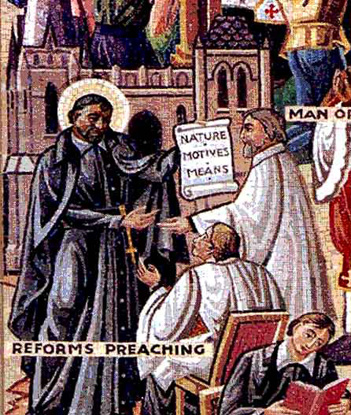
"To preach the gospel to the poor" is the motto of the Congregation of the Mission, and for Saint Vincent the way to do that was what he called the "Little Method"-nature, motives, and means. "The method is wonderfully efficacious for enlightening the mind and moving the will." "If we are to preach well and usefully, we must do so with simplicity, using ordinary language, so that everybody may be able to understand and profit by it."
In a conference on preaching, Monsieur Vincent gives us a glimpse of his use of it. "Reasons [motives] which urge us to have a great love of this method; in what this method consists [nature] so that we may know and be able to put it into practice in the future; I will suggest some means which may help us to acquire this method." This was his outline for that conference on preaching. Motive, nature, and means, all set out simply and clearly-such was Saint Vincent's "Little Method" by which preaching could be reformed.
Initiated Retreats
Initiated Retreats.
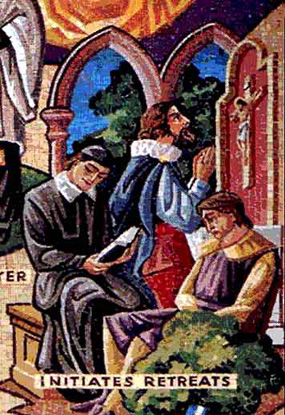
"The Company has a vocation for this employment; God has called us to it." Such were the sentiments of M. Vincent. He said to his confreres in a conference, "Some Communities send persons who intend to join them to better test their vocation. Others come from ten, twenty, fifty miles to decide of a state of life IN the world and to take means of working out their salvation therein. We also see a large number of parish priests and other ecclesiastics coming here from all parts to reflect on the manner in which they are exercising the duties of their sacred profession and to advance in the spiritual life."
As a rule there were eight or ten ecclesiastics and as many laymen on retreat at the Bons-Enfants and / or Saint-Lazare, the priory Saint Vincent took over in 1633 as the Motherhouse of the new Community. Women went to the Motherhouse of the Daughters of Charity, "The end is to become a perfect Christian and to be perfect in each one's own vocation: a perfect student, a perfect lawyer, if a lawyer, a perfect ecclesiastic, if a priest."
Saint Vincent considered retreats a gift from Heaven, although they were a serious drain on the resources of the Community.
Ladies of Charity
Ladies of Charity.
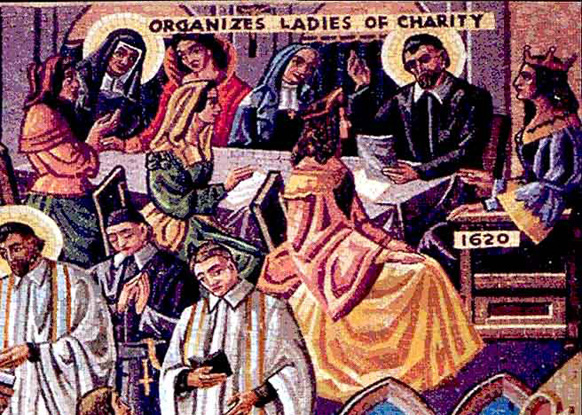
In 1656 Saint Vincent wrote to Jean Martin in Turin: "There are two sorts of Ladies in Paris who have joined together to assist the poor. The first are those in the parishes who take care of the sick and have some kind of regulations for doing this in a useful and orderly manner." The first parish Confraternity of Charity began in 1617–all were the practical result of a parish mission. The other group, forty or fifty in number, comprised the Confraternity of Charity of the Hôtel-Dieu founded in 1633. "Their charity is not so limited, but is extended to different places and in several ways, according to public needs. For some years they have been helping the poor folk on the frontiers and have assisted those in the environs of Paris during the wars." Saint Vincent led them to undertake several important services: abandoned children and the support of the foreign missions.
Ever the astute organizer, the Saint combined their spiritual growth with the regular meetings of these Ladies, and through a published bulletin, the Relations, he let others know of the work of all these devout and devoted Ladies.
Cofounded Daughters- St. Louise
Cofounded Daughters.
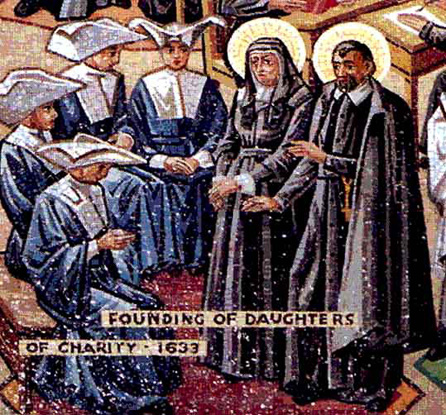
"And that, Sisters, is how the Company began. No one ever thought of it. That is the way in which God's works begin; they are accomplished without anyone thinking of them." The work of the parish Confraternities of Charity, begun by Saint Vincent, was completed by Mademoiselle Le Gras, Saint Louise de Marillac, who, under the direction of M. Vincent, visited the various Charities in and around Paris. To assisthem she gathered some country girls at her own house (November 29, 1633) and trained them to assisthe Charities. So important did they become that Vincent averred that the work of the Confraternities of Charity and the Ladies of Charity could not really succeed without their aid.
Under the title of Confraternity of Charity of the Servants of the Sick Poor, this young Company, with the approbation of the Archbishop of Paris given on January 18, 1655, officially established itself, August 8, 1655. Wherever they worked, in parishes, in various hospitals, with the galley slaves, those wounded in battle, with the foundlings-in a word, in all the areas of spiritual and corporal welfare of God's poor-they brought with them the virtues instilled in them by M. Vincent and MIle Le Gras: charity, humility, and simplicity, the signs of a Daughter of Charity.
Refuted Jansenism
Refuted Jansenism.
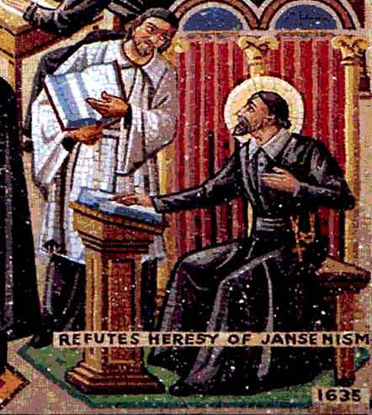
Throughout much of his priestly life M. Vincent combated the heresy of Jansenism which beset and divided the Church in France. The most fundamental of the Jansenists' controversial ideas dealt with the relationship of grace and free will, with salvation and the Jansenists' notion of predestination. Most striking were the controversies over the Sacraments of the Holy Eucharist and Penance. The Jansenists opposed frequent Communion and Church's practice of absolution of sins at the time of Confession.
Either as a leading member of the Council of Conscience or as an influential ecclesiastic in the kingdom, the Saint coordinated opposition to the Jansenists' doctrine; succeeded in unifying most of the French hierarchy and the heads of religious Orders against these errors; influenced the appointment of bishops and the doctrinal faculty of the Sorbonne. He rejoiced when Pope Innocent X (May 31, 1653) condemned the fundamental tenets of the Jansenists.
Panel 3
Man of Charity
Man of Charity.
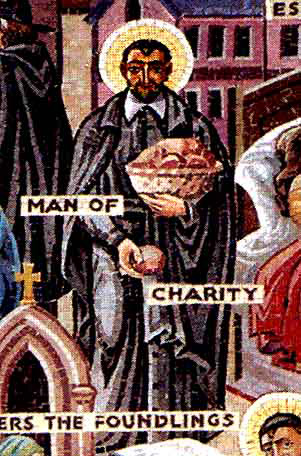
There was scarcely a meeting called to deal with devotional or charitable concerns to which Monsieur Vincent was not invited. He possessed all the qualities needed for the conception and execution of great designs: energy, initiative, courage, a genius for organizing a multiplicity of works that benefitted the abandoned and for energizing those who could implement his vision. Could it not be said that he carried within himself those qualities and intuitions native to his peasant background: prudence, a sound sense, disinterestedness, patience, and determination.
What he said to his confreres applies to all the Vincentian Family: "We are bound to show charity by leading people to love God and their neighbor; to love the neighbor for God and God for the neighbor. We have been chosen by God as instruments of his boundless and fatherly love." "Our vocation is to go throughout the whole world to inflame the hearts of men, to do what the Son of God did-to cast fire on the earth, to inflame it with His love. I am sent not merely to love God but to have Him loved."
After three centuries all the Saint's undertakings are still alive and vigorous, though often in modified forms. Such prolonged vitality is a proof of their solidity and of the excellent methods he adopted to secure them.
Cardinal Richelieu
Cardinal Richelieu.
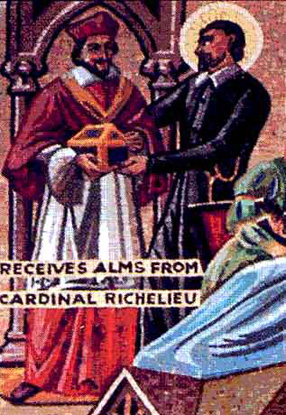
Historians provide us with a view of Armand Cardinal Richelieu, Prime Minister and an absolute power in France. The history of Vincent de Paul provides us with another insight into the Cardinal–and his niece, the Duchesse d' Aiguillon.
Richelieu freely consulted the Saint on ecclesiastical affairs; he urged M. Vincent to establish seminaries and contributed to their financial needs; he funded missions in the duchy of Richelieu and the diocese of Luçon; annually he contributed to the Charity in Richelieu.
For many years Richelieu and his niece worked together in the most perfect harmony in the practice of Christian charity. The generosity of the Duchesse d' Aiguillon, further enriched after the death of her uncle (1642), supplied the funds of which the house in Rome was in need; the apostolate in Tunis and Algiers was sustained by her largess, as was the spiritual and corporal care of the galley slaves. The Duchesse d' Aiguillon must be placed among the first rank of Saint Vincent's collaborators. Perhaps no one contributed more to him than this niece of Riche lieu, few were more attached to him.
1643– Dying Louis XIII
1643– Dying Louis XIII.
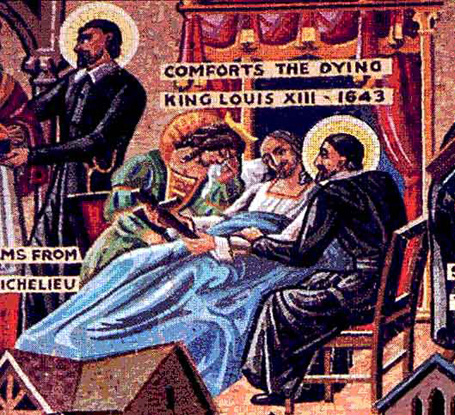
The Queen, Anne of Austria, with the consent of the King's confessor, Jacques Dinet, SJ, called M. Vincent to the bedside of Louis XIII on April 23, 1643. When his condition worsened, the King sent for Vincent a second time to help him in his final passage. The King's piety became ever more apparent as death approached. The Saint stayed for the last three days of the King's life. He was almost constantly in the Monarch's presence helping him to raise his mind and heart to God and to make those interior acts of piety appropriate to prepare his soul for that final moment upon which eternal happiness depends. The King asked M. Vincent, "What is the best preparation for death?" To which the Saint responded: "Sire, I can suggest nothing better than the example of Our Lord: complete and perfect submission of one's will to that of Our heavenly Father."
Louis XIII died on May 14, 1643. Saint Vincent wrote to Bernard Codoing in Rome: "As long as I have been in this world, I have never seen anyone die a more Christian death."
Foreign Missions
1647--Jean Le Vacher sent to foreign missions.
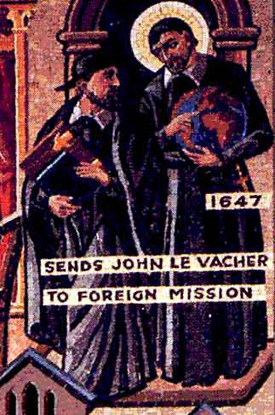
"He has a vocation for that," Saint Vincent told the Nuncio of the Holy See to France when he introduced Jean Le Vacher to him in 1647. Shortly after Le Vacher's ordination to the priesthood, the Saint selected this young confrere, remarkable for his exceptional ability and admirable zeal, and sent him to Tunis where he spent most of his priestly life and where he was martyred in 1683, blown asunder while tied to the mouth of a cannon.
During his missionary apostolate in Tunis he served as Vicar General of the Archbishop of Carthage, in which task he had jurisdiction over all Christians residing in Tunis, both merchants and slaves. Priests and members of Religious Orders who were slaves received all their faculties through him. In addition, on the orders of the Dey he often served as Consul for France in Tunis.
Saint Vincent fostered the vocation to foreign missions among his confreres in various conferences: "Let us ask Him to give us the spirit of going to all places, of suffering imprisonment and torture, and of never allowing anything to hinder us from laboring for the salvation of our neighbor." In Saint Vincent's era many heeded the call of the neighbor in Ireland, Scotland and the Hebrides, Barbary, and Madagascar.
Aids the Poor
Aids the Poor.
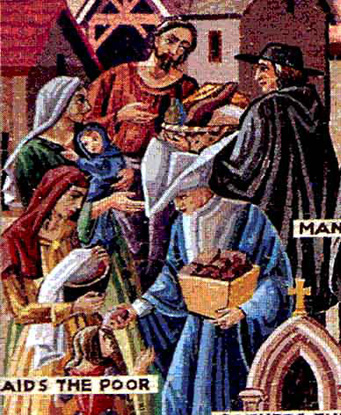
"The principal concern of this charitable priest was to serve the poor. "Those who love the poor in life will have nothing to fear in death." Monsieur Vincent wrote to Thomas Berthe in Rome: "It is a source of consolation to us that Our Lord seems to want to use the Company everywhere for the service and relief of he poorest of the poor." He urged the Daughters of Charity to serve the poor well, not only corporally, but spiritually. "We should not, indeed, be doing enough for God and our neighbor if we supplied the poor sick only with nourishment and medicine and if we did not assist them, according to God's designs, with the spiritual services we owe them."
Today, Saint Vincent urges all his family as he did those in his day: serve the Lord corporally and spiritually in the person of the poor, now in the guise of a child, in that of the homeless, in the sick, and as prisoners. In a word, as he, with tender love and paternal care, became a sort of general overseer of help to the poor wherever they were, so should we as we strive to emulate him.
Establishes Hospitals
Establishes Hospitals.
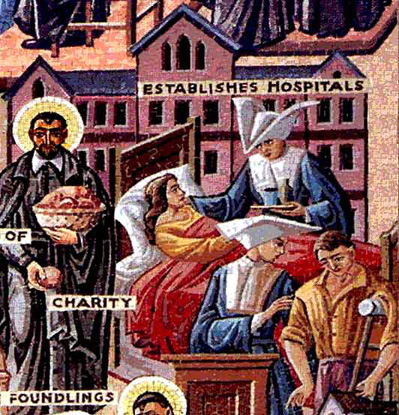
Besides parishes where they nursed the sick poor in their homes, the Daughters of Charity worked in five hospitals in Paris and eight outside the city; in many of them Vincentians were the chaplains.
Saint Vincent wrote to Jean Martin in 1657: "In Paris they are trying to establish a large hospice where all the poor beggars will be fed, instructed, and given something to do and will no longer be seen around the city nor in the churches." The Vincentians and Daughters of Charity were given its direction by Royal decree and the approval of the Archbishop. In 1653 an anonymous rich merchant gave M. Vincent a hundred thousand livres for a good work of the Saint's choice. He started the Nom-de-Jesus hospice for male and female artisans who could no longer earn a living because of age or infirmity. The contract stipulated that Saint Vincent would provide spiritual directors from among his confreres.
Enlightening about the apostolate in hospitals is a letter to a Brother in Genoa: "In hospitals many painful crosses and contradictions are encountered -work is heavy, times of rest are short and interrupted, repugnance is certain, and reproaches and insults are frequent there. Almost all the poor grumble about things because they are never satisfied and usually complain." A true field of dreams for the sons and daughters of Saint Vincent.
Gathers Foundlings
Gathers Foundlings.
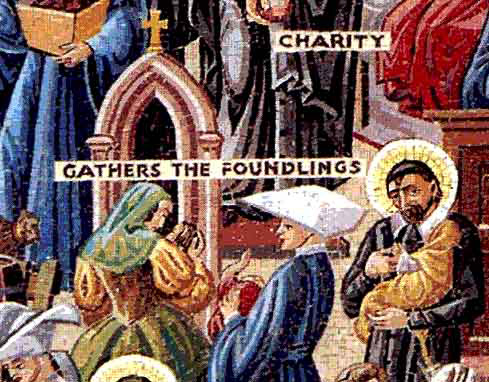
It has been estimated that some three hundred / four hundred babies were abandoned every year in Paris. Thanks to the efforts of Saint Vincent de Paul, these abandoned infants took on a new lease in life. At his request the Ladies of Charity of the Hôtel-Dieu in 1638 assumed the responsibility for these children- aided by the Daughters of Charity. By 1640 they were able to accept all foundlings brought to them. Thirteen houses (Treize-maisons) on the Champ-Saint-Laurent, near Saint-Lazare, were opened for them in 1645; in 1647 the Foundling Hospital called Bicêtre received these abandoned children.
The cost of this work can be gleaned from Saint Vincent's talk to the Ladies of Charity at their General Assembly in 1647. M. Vincent enquired: Should the Company of the Ladies of Charity continue or abandon the work on behalf of the foundlings? He examined reasons for and against and reminded them of the good that had so far been accomplished. He concluded: "So now, Ladies, sympathy and charity led you to adopt these little creatures as your children, you have been their mothers according to grace, ever since their mothers according to nature abandoned them; reflect now whether you, too, intend to abandon them. Cease to be their mothers and become their judges; their life and death are in your hands; I am now about to collect your opinions and votes; the time has come to pronounce their sentence and to see if you still desire to have mercy on them. They will live if you continue to take charitable care of them, and, on the contrary, they will infallibly die and perish, if you abandon them; experience does not allow you to think otherwise."
The Ladies pronounced sentence, and it was a sentence of mercy. They unanimously resolved to continue to assist the foundlings.
Aids the poor Provinces
Aids the poor Provinces.
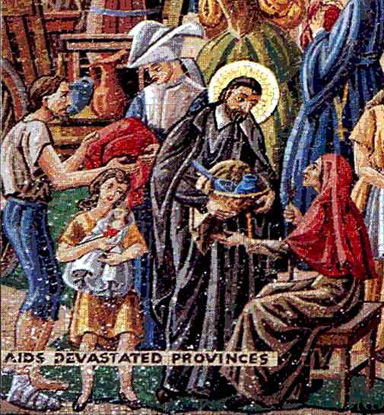
"We have had so much misery in the very heart of France. What must be the state of these poor people living on the frontier," Saint Vincent said to his confreres in 1655. Wars beset Europe (Thirty Years War) and France suffered from the Fronde (1648-1652). These upheavals left them "in a state of wretchedness and misery. If they sowed, they had no certainty of reaping; armies arrived and pillaged."
Saint Vincent entrusted his Missionaries with the distribution of relief. Some sixteen priests and eighteen Brothers were involved in the relief of the devastated Provinces. Of these Brothers Jean Parre and Mathieu Régnard are noteworthy; they were two of the most intelligent and active instruments that Divine Providence placed in the Saint's hands.
Parre traveled all over Picardy and Champagne assessing needs and delivering relief from the Ladies of Charity: distributed money to repair churches and stipends for Masses; supplied farmers with seed and implements; workmen with tools; cloths were distributed.
Régnard was the principal distributor of alms in Lorraine. His daring, composure, and savoir-faire made him invaluable to the Saint. Regnard made some fifty-three trips to Lorraine, carrying sums of money each time varying between 20,000 and 50,000 livres--he always arrived safely at his destination with his treasures; never waylaid by bandits or soldiers.
The Ladies of Charity worked with tireless charity, at unbelievable expense, helping these afflicted by the scourge of war. The RELATIONS they published–reports of needs, how alleviated, and thank you notes-provide us with a kaleidoscope of what the Ladies and Missionaries did for the devastated Provinces.
Houses Homeless Girls
Houses Homeless Girls.
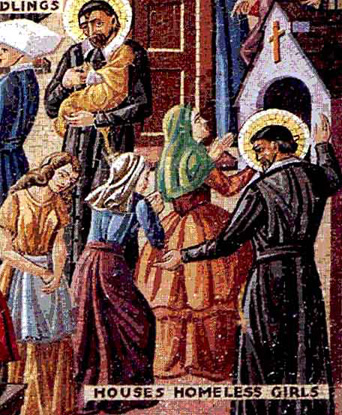
War, plague, and famine were wrecking havoc on the devastated Provinces, as already mentioned. A good number of people from there came to Paris counting on fighting destitution more easily there. Saint Vincent wrote: "Paris is swarming with poor persons because the armies have forced the country folk to seek refuge here. Meetings are held daily to see if they can be helped. A few houses have been rented where some of them have been housed, particularly, poor girls." Some of the older girls were tempted to sell themselves rather than starve. Several religious communities were on the verge of breaking their cloister to seek food.
In 1639 Saint Vincent wrote to Saint Louise: "Here are three poor people from Lorraine who arrived yesterday evening. One woman has a child. We shall try to get her a place at the Refuge." It was ordinarily a place of involuntary shelter for women and girls who were judged to be leading a disorderly life.
In 1652 some 20,000 refugees were wandering the streets, living in questionable places, staying with relatives. "We have a hundred in one house in the Faubourg Saint-Denis. We are going to rescue from the same danger the nuns from the country." These relief efforts lasted some seven more years.
Panel 4
Tuesday Conferences
Tuesday Conferences.
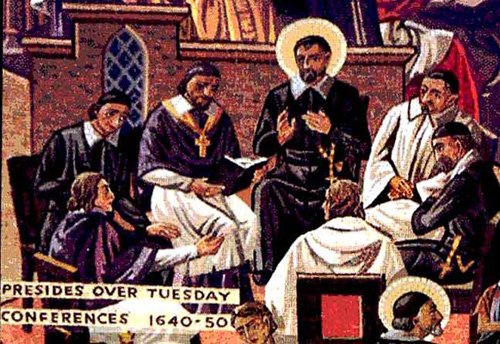
To serve ongoing education and the spiritual development of priests selected for their proven holiness and learning M. Vincent initiated what came to be called in Paris the Tuesday Conferences. They proved to be another integral part in the Tridentine reform of the clergy in which Vincent took part.
The Saint wrote: "The goal of this assembly is to attend to their own perfection; to make the means of seeing that God be not offended, but that He be known and served in their households; and to procure His glory among ecclesiastics and the poor." To do this members committed themselves to meet every Tuesday at Saint-Lazare or the Bons-Enfants to honor the life of Christ the Eternal Priest; to celebrate Mass daily and confess once a week to a regular confessor; to make a spiritual retreat annually; to spend some time each day in mental prayer and Divine Office; to read the New Testament; to make an examination of conscience; to attend the funeral of members; and to offer three Masses for the souls of deceased members.
The Superior General of the Congregation of the Mission, M. Vincent, or his delegate, directed the Conference at Saint-Lazare. Similar Conferences, modeled on that of Saint-Lazare, were organized in dioceses throughout France and Italy. The distinguishing features of these meetings were their simplicity and the humility and charity of the members. More that 250 priests attended during Saint Vincent's lifetime.
Council of Conscience
Council of Conscience.
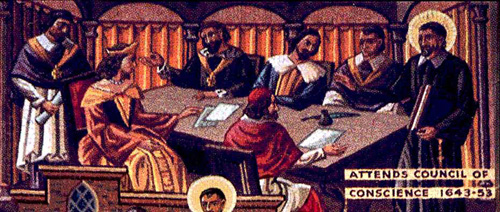
Prior to their deaths (1642 and 1643), Monsieur Vincent had advised Cardinal Richelieu and Louis XIII on the appointment of bishops. Created by the Queen-Regent, Anne of Austria, in 1643, the Royal Council for Ecclesiastical Affairs–Council of Conscience–discussed and decided all questions dealing with religion in.France. The Queen presided and appointed the members. Vincent accepted his nomination with great reluctance, begging the Queen unsuccessfully to dispense with his services.
During the ten years of his tenure in this office, Saint Vincent never missed an occasion to prevent unworthy men from obtaining dioceses and benefices, and he worked for the preservation of the faith and discipline. Of all the questions considered by the Council of Conscience, the Saint believed that none equaled in importance the choice of bishops. The good of the Church and the well being of souls outweighed any political and personal considerations. M. Vincent often opposed Cardinal Mazarin's view-they were pursuing different and often contrary goals.
When the Queen selected a nominee for a bishopric, Saint Vincent then spoke to the bishop-elect of his duties. The Queen wrote to one such bishop: "I beg you to be good enough to see M. Vincent, who will be quite pleased to place his knowledge and wisdom at your disposal in all matters regarding this function."
Thanks to Saint Vincent, many dioceses and abbeys were governed by pastors animated by an apostolic zeal that formed a striking contrast with the worldliness of their seniors in the episcopacy.
Anne of Austria
Anne of Austria.
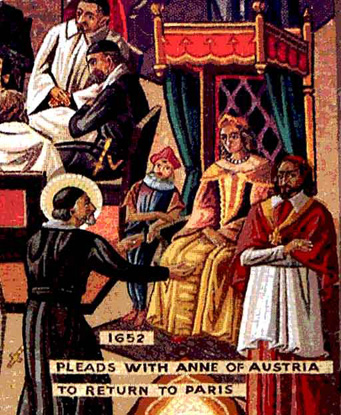
The Queen-Regent had conceived a profound admiration for Vincent de Paul, put her trust in him, and profited by the advice which he gave her for the good of her soul and the welfare of the State. But at the same time the relationship of the Anne of Austria and Cardinal Mazarin, the Prime Minister, was troubling. Parlement, the nobility, and the people wanted Mazarin ousted–“were ready to do anything to bring about Mazarin's dismissal," even the civil war called the Fronde.
"I left Paris on the fourteenth of this month (January 1649)," wrote Saint Vincent to Antoine Portail, "to go to Saint-Germain with the intention of rendering some small service to God, but my sins rendered me unworthy of this." He described the dreadful misery in Paris and told the Queen clearly that the most efficacious remedy for the Fronde was to dismiss her Minister. He spoke just as frankly to Mazarin. Saint Vincent could not return to Paris because the Queen became angry with anybody who suggested that she capitulate and the people conjured up some betrayal by M. Vincent. For some five months he visited the various Community houses in France-exiled from Paris.
In May 1652 the Saint wrote, "I have not seen the Queen in six or seven months." On September 11, 1652 he wrote to Mazarin urging him to bring the Queen and the young King back to Paris. The people were clamoring for the Queen and King: "There is no one anywhere who does not say the same thing to me." Saint Vincent's frankness did not please Mazarin who informed Vincent that his presence was no longer needed at the Council of Conscience.
Common Rules
Distribution of the Common Rules.
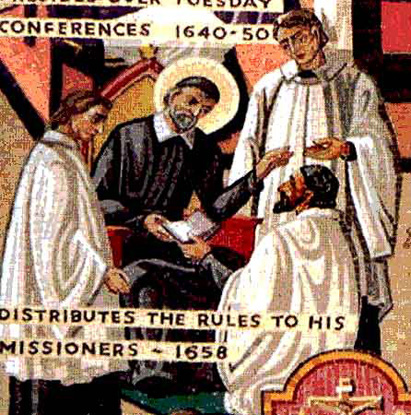
On Friday evening, May 17, 1658, after a discourse on Observance of the Rules, the holy Founder had the happiness of distributing to his confreres the precious little book which would supply them with means of sanctifying themselves and their fellow man-the Common Rules approved by the Archbishop of Paris, Jean-François-Paul de Gondi.
There is "nothing in them that you have not already practiced for a long time." General Assemblies in 1641 and 1651 discussed Rules; M. Vincent sought the advice of theologians and renowned canonists, man of whom were in prominent positions in Rome. Throughout there is evidence of the prudence, moderation, charity, and zeal with which he prepared the Rules of the Congregation. He would write, "The Rules and Constitutions are produced not by the human mind but rather by God's inspiration." "We have attempted to base these Rules totally on the spirit of Jesus Christ and to draw them from a consideration of His life." "They help us to procure the salvation of souls, to serve the Church, and to give glory to God."
Vincent receives Viaticum
Vincent receives Viaticum.
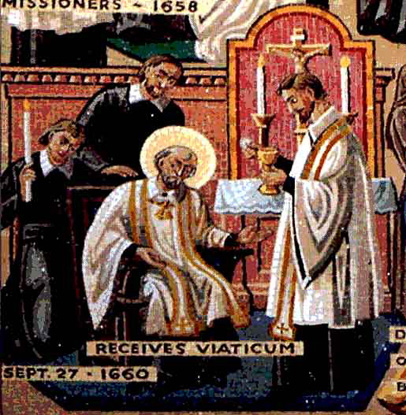
By 1660 M. Vincent's legs became so bad that he was no longer able to offer Mass. He continued to attend, however, until the day of his death, hobbling from his room to the chapel with the help of crutches; in August he consented to having a chair made so that he could be carried to the infirmary chapel for Mass.
Seeing his end approaching, the Saint disposed himself interiorly. On Sunday, September 26, he had himself carried to the chapel for Mass and Holy Communion. The effort he had made exhausted his strength, and on his return to his room he was beset by drowsiness. That evening he was asked if would like to receive the Last Sacraments. He replied with a simple "yes," and Father Jean Dehorgny administered them
At 4:45 on the morning of September 27, without any convulsions or struggle, he breathed his last. God called him to Himself. He died, sitting in his chair, close to the fire, fully dressed, by a seeming gradual weakening of nature, "like a lamp going out as the oil is used up."
The family of Saint Vincent is blessed with a journal of the last days of M. Vincent written by M. Jean Gicquel.
Patron of Charity
Patron of Charity.
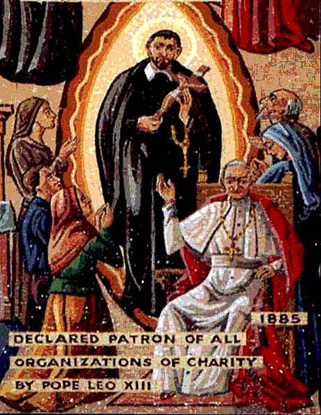
Attestation of the sanctity of Vincent de Paul began in due course and two hundred and ninety witnesses gave evidence at the beatification process. On August 13, 1729, Benedict XIII inscribed him in the catalogue of the Blessed; Pope Clement XII proclaimed his sainthood on June 10, 1737.
In 1883, the Society of Saint Vincent de Paul was preparing to celebrate the golden jubilee of its foundation by Frederick Ozanam. A Papal Brief, issued on June 22 of that year, proclaimed: "Yielding to the wishes of all and desiring to arouse the devotion of the faithful for this hero of charity, we declare Saint Vincent de Paul special patron with God of all charitable associations which in any degree whatsoever .emanate from him and are to be found in French territory."
Saint Vincent was to be recognized and venerated throughout France and its dependencies as patron of all pious associations and works of Christian charity declared Pope Leo XIII.
At the urging of Antoine Fiat, the Superior General of the Congregation of the Mission and the Company of the Daughters of Charity, petitions from bishops from around the world were sent to Rome–they requested that Saint Vincent's patronage be extended to all countries. Faced with this flood of petitions, the Holy See realized that the moment had come to consider universal patronage of all works of charity. Pope Leo XIII declared him such on May 12, 1885.

